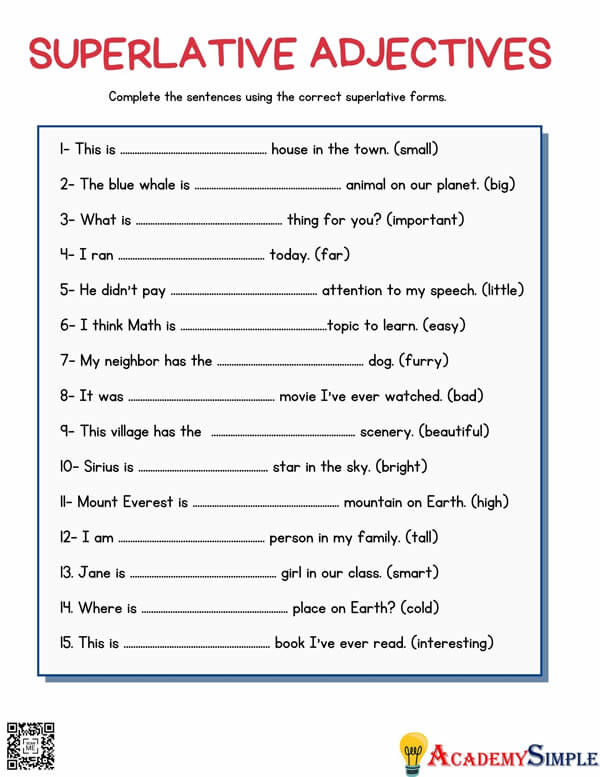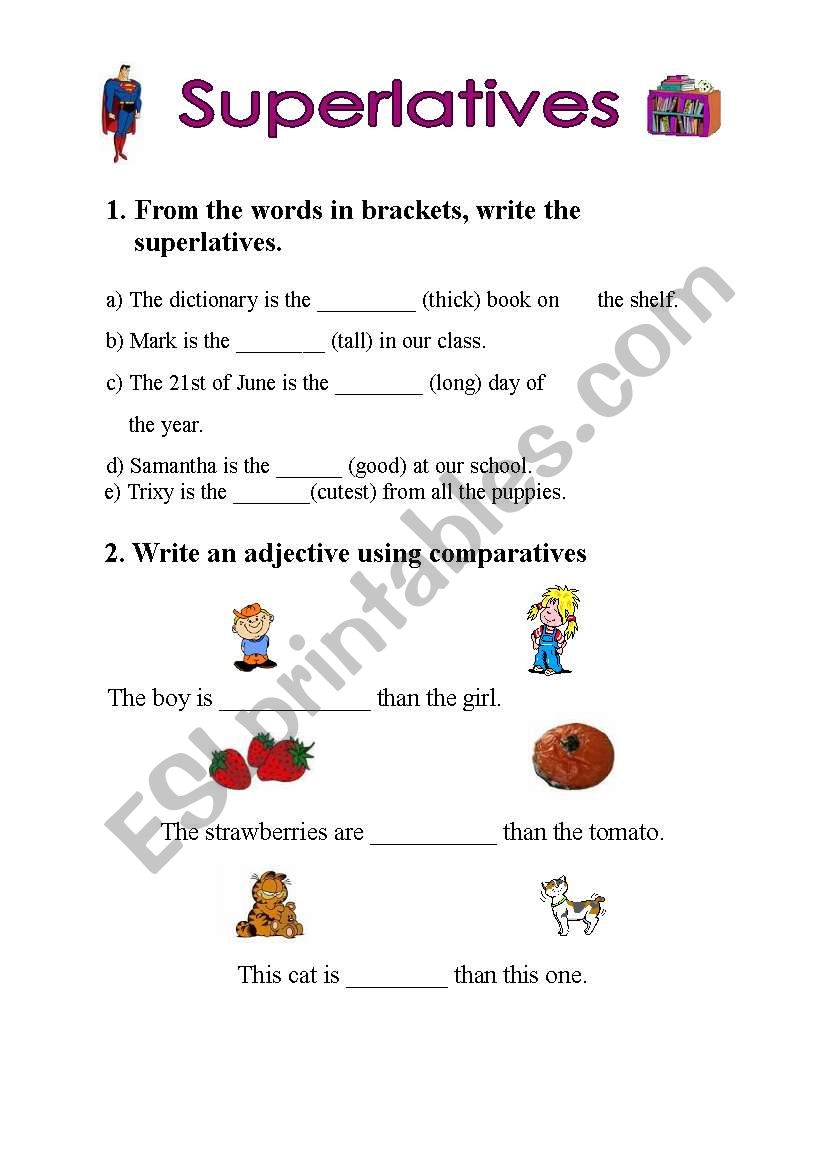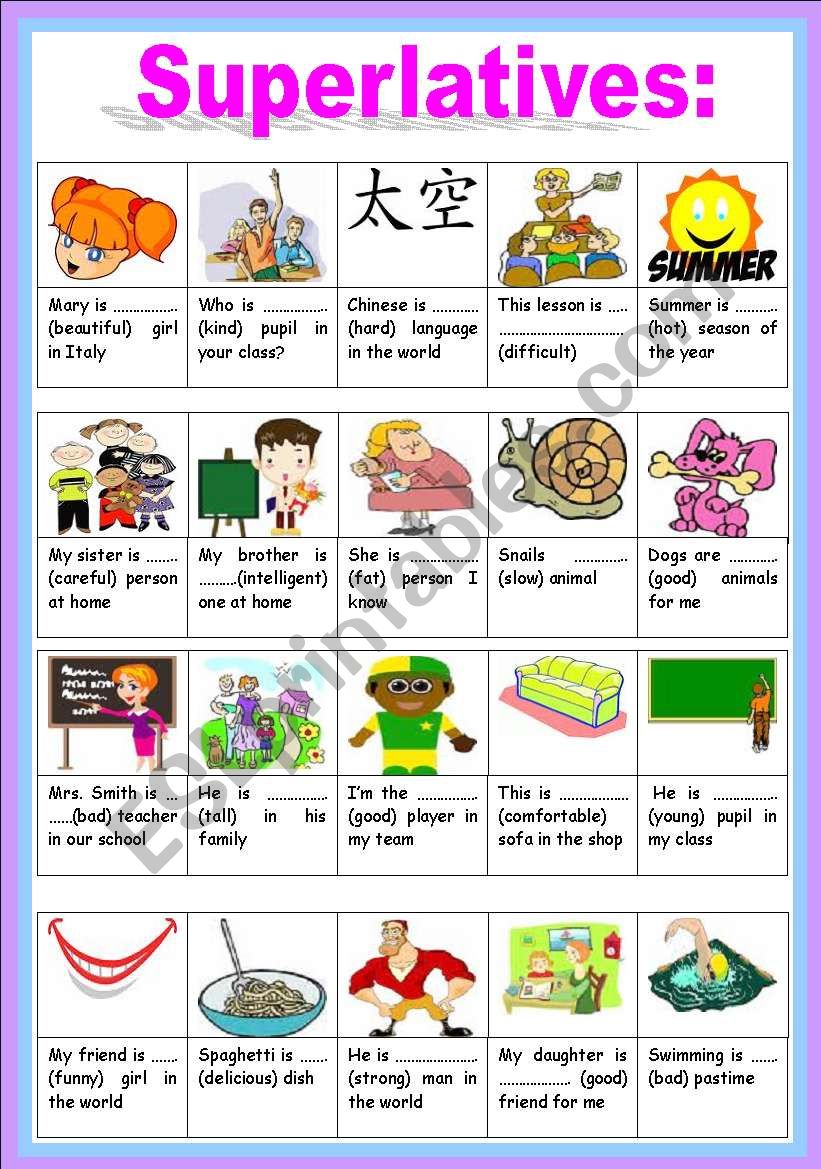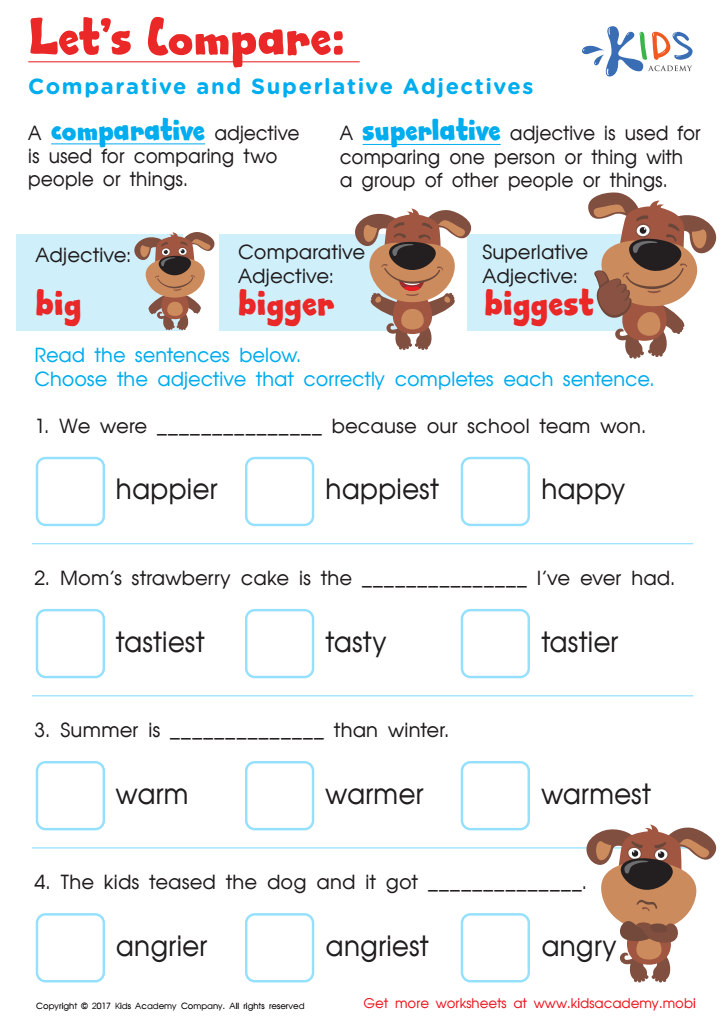
Mastering the Extremes: The Indispensable Role of a Forming Superlatives Worksheet
In the vast landscape of English grammar, mastering adjectives and adverbs is crucial for effective communication. These parts of speech allow us to add color, detail, and precision to our language, painting vivid pictures with words. Among these, superlatives stand out as a powerful tool, enabling us to express the absolute highest or lowest degree of a quality within a group. Whether we’re describing the tallest building, the fastest runner, or the most beautiful sunset, superlatives are essential for conveying extremes. One of the most effective and widely used tools for solidifying this understanding and ensuring correct application is a well-designed forming superlatives worksheet.
Understanding Superlatives: The Apex of Comparison
Before delving into the utility of a worksheet, it’s vital to grasp what superlatives truly are. In English, adjectives and adverbs typically exist in three forms:

- Positive Form: The basic form of the adjective or adverb (e.g., tall, fast, beautiful, carefully).
- Comparative Form: Used to compare two things (e.g., taller, faster, more beautiful, more carefully).
- Superlative Form: Used to compare three or more things, indicating the one that possesses the quality to the greatest or least degree (e.g., tallest, fastest, most beautiful, most carefully).




Superlatives almost always require the definite article "the" before them, as they pinpoint a unique item or individual within a group. For instance, you wouldn’t just say "tallest building," but "the tallest building."
The formation of superlatives generally follows two main patterns:
- Adding "-est": For most one-syllable adjectives and some two-syllable adjectives ending in -y (which changes to -i before -est). Examples: cold – coldest, happy – happiest, large – largest.
- Using "most": For adjectives with two or more syllables (that don’t end in -y) and for most adverbs. Examples: expensive – most expensive, difficult – most difficult, gracefully – most gracefully.


However, as with many aspects of English, there are irregular forms that do not follow these rules, such as good – best, bad – worst, far – furthest/farthest, little – least, much/many – most. These irregularities often pose a significant challenge for learners, underscoring the need for dedicated practice.
Why Superlatives Matter: Beyond Just Grammar

The importance of mastering superlatives extends far beyond simply adhering to grammatical rules. They are fundamental for:
- Clarity and Precision: Superlatives allow us to make definitive statements about extremes, leaving no room for ambiguity. Saying "Mount Everest is the highest mountain" is far more precise than "Mount Everest is a high mountain."
- Descriptive Power: They enhance our ability to describe the world around us with greater nuance and impact. Imagine trying to describe a grand canyon without being able to call it "the deepest" or "the most awe-inspiring."
- Expressing Opinions and Judgments: Superlatives are crucial for expressing preferences, making judgments, and ranking things. "This is the best movie I’ve ever seen," or "That was the worst decision."
- Effective Communication in Various Contexts: From academic writing and professional reports to casual conversations and creative storytelling, superlatives are an integral part of expressing complex ideas concisely and powerfully. They are used in comparisons, advertisements, news headlines, and virtually every form of communication where a peak quality needs to be highlighted.

Common Challenges in Forming Superlatives
Despite their apparent simplicity, learners often encounter several hurdles when forming and using superlatives correctly:
- Choosing Between "-est" and "most": This is perhaps the most common pitfall. Students struggle to remember which rule applies to which adjective or adverb, especially with two-syllable words that might sometimes take "-est" (like cleverest) and sometimes "most" (like most modern).
- Spelling Rules: Adjectives ending in a single consonant preceded by a single vowel often require doubling the final consonant before adding "-est" (e.g., big – biggest, hot – hottest). Adjectives ending in "-y" require changing the "y" to "i" (e.g., happy – happiest, easy – easiest). These subtle spelling changes can be easily overlooked.
- Irregular Forms: Words like good/best, bad/worst, far/furthest are pure memorization and often cause confusion due to their unpredictable nature.
- Usage of "the": Forgetting the definite article "the" before the superlative form is a very common error.
- Adjectives vs. Adverbs: Distinguishing when to use the superlative form of an adjective (describing a noun) versus an adverb (describing a verb, adjective, or another adverb) can be tricky.
This is precisely where a dedicated forming superlatives worksheet truly shines as an invaluable educational resource.
The Power of the Forming Superlatives Worksheet
A forming superlatives worksheet is more than just a collection of exercises; it’s a structured learning tool designed to address the aforementioned challenges systematically. It provides targeted practice, reinforces rules, and allows learners to internalize the correct patterns through repetition and varied application.
Here’s why a worksheet is so effective:
- Structured Practice: Worksheets break down the complex topic of superlatives into manageable, bite-sized tasks. They guide learners through different scenarios, from basic formation to contextual usage.
- Repetition and Reinforcement: Like any skill, grammar requires practice. A worksheet offers ample opportunities for learners to repeat the rules and apply them, helping to solidify their understanding and move knowledge from short-term to long-term memory.
- Identification of Weaknesses: As learners complete the exercises, both they and their instructors can identify specific areas of difficulty. Is it the "-est" vs. "most" rule? The irregular forms? The spelling changes? This diagnostic capability allows for targeted intervention and further practice.
- Self-Paced Learning: Worksheets can be completed at a learner’s own pace, allowing them to spend more time on challenging areas without feeling rushed.
- Assessment Tool: For educators, a worksheet serves as an excellent formative or summative assessment tool. It provides tangible evidence of a student’s comprehension and ability to apply the rules.
- Versatility: A worksheet can be used for individual practice, paired work, group activities, homework, or as a quick warm-up or cool-down activity in the classroom.
Key Features of an Effective Forming Superlatives Worksheet
Not all worksheets are created equal. An effective forming superlatives worksheet should possess several key characteristics to maximize its learning potential:
- Clear Instructions: Ambiguous instructions can hinder learning. The worksheet should clearly state what is expected of the learner for each exercise.
- Gradual Difficulty: It should ideally progress from simpler tasks (e.g., forming superlatives from a list of words) to more complex ones (e.g., filling in blanks in sentences, correcting errors, writing original sentences).
- Variety of Exercise Types:
- Simple Conversion: Provide a list of adjectives/adverbs and ask learners to write their superlative forms.
- Fill-in-the-Blanks: Sentences with blanks where learners must choose and correctly form the superlative.
- Sentence Construction: Give a positive adjective and ask learners to create a sentence using its superlative form.
- Error Correction: Provide sentences with incorrect superlative usage and ask learners to identify and correct them.
- Contextual Application: Short paragraphs or dialogues where learners must insert the appropriate superlative to make sense.
- Comparative vs. Superlative: Exercises that require learners to distinguish between comparative and superlative forms, reinforcing the nuanced difference.
- Inclusion of Irregular Forms: Ample practice with irregular superlatives (best, worst, furthest/farthest, least, most) is crucial.
- Focus on Spelling Rules: Exercises specifically designed to test the doubling of consonants or the ‘y’ to ‘i’ change are very beneficial.
- Thematic Content: Using engaging themes (animals, sports, travel, famous landmarks) can make the worksheet more interesting and relatable for learners.
- Answer Key: For self-assessment and immediate feedback, an answer key is invaluable, especially for independent study.
- Clear Layout and Design: A visually uncluttered and easy-to-read layout reduces cognitive load and makes the learning process more enjoyable.
Maximizing the Effectiveness of a Forming Superlatives Worksheet
To get the most out of a forming superlatives worksheet, both learners and educators can employ various strategies:
- For Learners:
- Review Rules First: Before attempting the worksheet, briefly review the rules for forming superlatives, including irregular forms and spelling changes.
- Work Systematically: Don’t rush. Take time to think about each word and sentence.
- Check Answers: Use the answer key (if provided) to check work immediately. Understand why an answer was correct or incorrect.
- Identify Patterns of Error: If consistently making the same mistake, make a note of that rule and dedicate extra practice to it.
- Practice Speaking: After completing the written exercises, try forming superlative sentences orally.
- For Educators:
- Introduce Clearly: Begin with a clear explanation of superlatives, using visual aids and examples.
- Model First: Demonstrate how to complete a few exercises before setting students to work independently.
- Differentiate: Provide different versions of the worksheet for learners at varying proficiency levels, or offer extension activities for advanced students.
- Encourage Peer Review: Have students exchange worksheets and correct each other’s work, fostering collaborative learning.
- Follow Up: Don’t just assign and collect. Review common errors as a class, discuss tricky examples, and provide additional support where needed.
- Integrate with Other Activities: Use the worksheet as a springboard for creative writing, debates, or descriptive games that require superlative usage.
Beyond the Worksheet: Reinforcing Superlatives in Real-World Contexts
While a forming superlatives worksheet is a cornerstone of learning, it should be part of a broader strategy for mastering superlatives. Real-world application is key to true fluency.
- Reading: Encourage reading materials that naturally use superlatives (e.g., travel guides, advertisements, articles comparing products). Ask students to identify and analyze their usage.
- Listening: Watch movies, listen to podcasts, or engage in conversations, paying attention to how native speakers use superlatives.
- Speaking Activities:
- "Who is the…?" games: "Who is the tallest in the class?", "Who is the most organized?"
- Debates/Discussions: "What is the best type of music?", "What is the most important invention?"
- Descriptive Tasks: Describe a picture using as many superlatives as possible.
- Writing Activities:
- Comparisons: Write paragraphs comparing different items, places, or people, naturally incorporating superlatives.
- Reviews: Write reviews of movies, books, or restaurants, using superlatives to express strong opinions.
- Journaling: Encourage students to describe their "best" or "worst" experiences.
- Technology: Utilize online quizzes, interactive grammar games, and language learning apps that provide dynamic practice with superlatives.
Conclusion
Mastering superlatives is an essential step in developing advanced English proficiency. It allows learners to express the highest degrees of qualities, make precise comparisons, and communicate with greater impact and nuance. The journey to this mastery is significantly aided by a well-crafted and strategically used forming superlatives worksheet.
By providing structured practice, reinforcing rules, and allowing for the identification of specific learning gaps, a forming superlatives worksheet serves as an indispensable tool for both educators and students. It lays the foundational knowledge required for accurate formation, which can then be built upon through real-world application in speaking, listening, reading, and writing. Through consistent engagement with a comprehensive forming superlatives worksheet and complementary activities, learners can confidently navigate the world of extremes and wield the power of superlatives with precision and flair.
